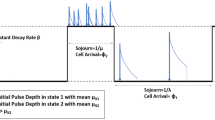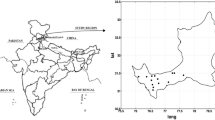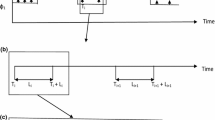Abstract
This paper examines the success of various Markov-chain models of daily precipitation series in reproducing the characteristics of area-average rainfall in Britain. The first model considered is the standard twos-tate first-order Markov renewal process coupled to an amount model using the incomplete Γ-probability distribution. We find that variability of seasonal totals and autocorrelation of daily amounts are both too small in this model, compared with observations. These are serious deficiencies, often overlooked, and possibly related. We proceed to consider models involving Markov chains of higher (temporal) order and many states, both of which generalizations may increase autocorrelation. A second-order two-state model is no better than the first-order, but a first-order many-state model captures a high fraction of the seasonal variability, because use of many states improves the model's representation of spells of heavy precipitation, which appear to have a considerable influence on the seasonal variance. Better still is a second-order many-state model, a type which, to our knowledge, has not previously been investigated. We suggest that the best model would have a continuum of states, rather than a discrete set. Our conclusion is that a large proportion of seasonal variability may be explained in terms of the average daily structure, but there may be a residual component caused by processes operating on longer time-scales and possibly predictable with reference to these. Reproduction of long-period (e.g. monthly or seasonal) variance and of the structure of daily autocorrelation provide crucial tests of stochastic “weather generators”, and we recommend that models which fail to simulate these statistics realistically be used only with great caution.
Similar content being viewed by others
References
Cole, JA, Sherriff JDF (1972) Some single- and multi-site models of rainfall within discrete time increments. J. Hydrol 17: 97–113
Cole JA, Slade S, Jones PD, Gregory JM (1991) Reliable yield of reservoirs and possible effects of climate changes. Jydrol Sci J 36:579–598
Gabriel KR, Neumann J (1962) A Markov chain model for daily rainfall occurrence at Tel Aviv. Q J R Meteorol Soc 88:90–95
Gregory JM, Jones PD, Wigley TML (1991) Precipitation in Britain: an analysis of area-average data updated to 1989. Int J Climatol 11:331–345
Gregory JM, Wigley TML, Jones PD (1992) Determining and interpreting the order of a two-state Markov chain; application to models of daily precipitation. Water Resour Res 28:1443–1446
Haan CT, Allen DM, Street JO (1976) A Markov chain model of daily rainfall. Water Resour Res 12:443–449
Katz RW (1977) Precipitation as a chain-dependent process. J Appl Meteorol 16:671–676
Katz RW (1985) Probabilistic models. In: Murphy AH, Katz RW (eds) Probability, statistics and decision making in the atmospheric sciences. Westview Press, Boulder, Colorado, pp 261–288
Madden RA, Shea DJ (1983) Potential long-range predictability of precipitation over North America. Proc 7th Annual Climate Diagnostics Workshop, NOAH, Washington, pp 423–426
Natural Environment Research Council (1975) Statistics for flood hydrology. Flood Studies Rep, vol I, NERC, London, pp 24–106
Reed DN (1986) Simulation of time series of temperature and precipitation over eastern England by an atmospheric general circulation model. J Climatol 6:233–253
Roldán J, Woolhiser DA (1982) Stochastic daily precipitation models: 1 a comparison of occurrence processes. Water Resour Res 18:1451–1459
Singh SV, Kripalani RH (1986) Analysis of persistence in daily monsoon rainfall over India. J Climatol 6:625–639
Stern R, Coe R (1984) A model fitting analysis of daily rainfall data. J R Stat Soc A147:1–34
Thom HCS (1958) A note on the gamma distribution. Mon Weather Rev 86:117–122
Thomas MM, Barr DR (1977) An approximate test of Markov chain lumpability. J Am Stat Assoc 72:175–179
Todorovic P, Woolhiser DA (1975) A stochastic model of n-day precipitation. J App Meteorol 14:17–24
Wigley TML, Jones PD (1987) England and Wales precipitation: a discussion of recent changes in variability and an update to 1985. J Climatol 7:231–246
Wigley TML, Lough JM, Jones PD (1984) Spatial patterns of precipitation in England and Wales and a revised, homogeneous England and Wales precipitation series. J Climatol 4:1–25
Wilks DS (1989) Conditioning stochastic daily precipitation models on total monthly precipitation. Water Resour Res 25:1429–1439
Woolhiser DA, Roldán J (1986) Seasonal and regional variability of parameters for stochastic daily precipitation models: South Dakota, USA. Water Resour Res 22:965–978
Author information
Authors and Affiliations
Rights and permissions
About this article
Cite this article
Gregory, J.M., Wigley, T.M.L. & Jones, P.D. Application of Markov models to area-average daily precipitation series and interannual variability in seasonal totals. Climate Dynamics 8, 299–310 (1993). https://doi.org/10.1007/BF00209669
Received:
Accepted:
Issue Date:
DOI: https://doi.org/10.1007/BF00209669




